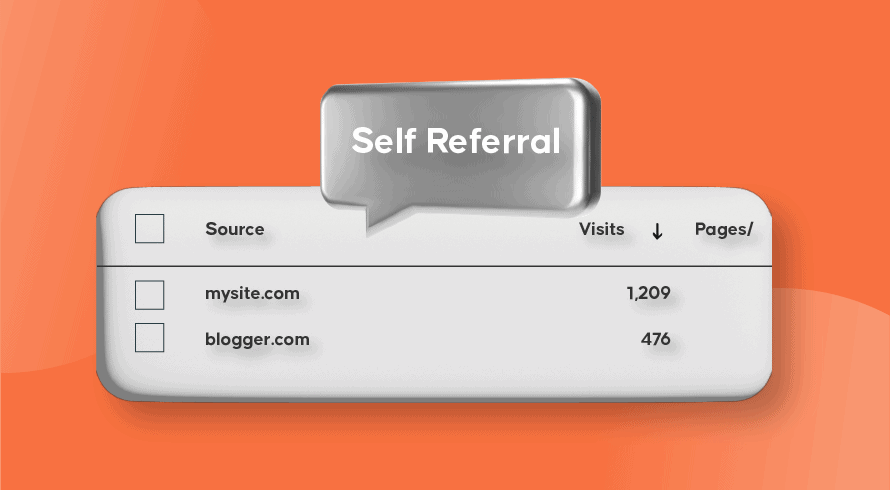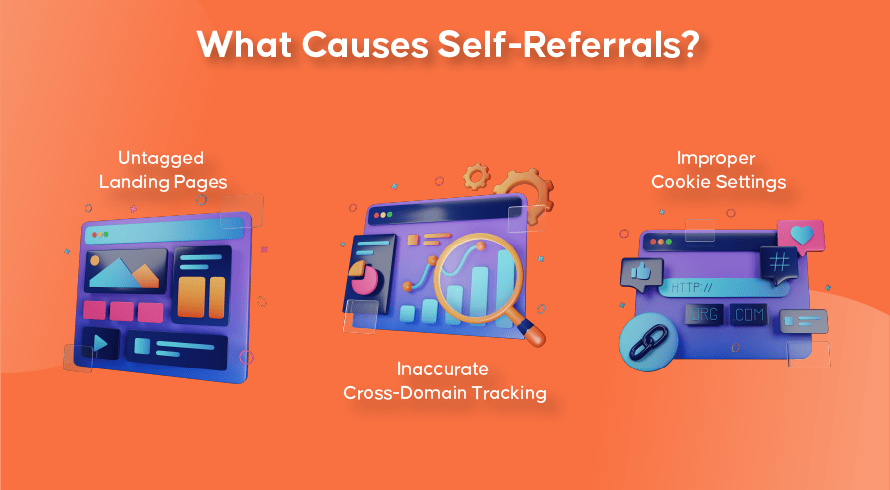Inquivix HQ
1-903, 18 Eonju-ro 146-gil,
Gangnam-gu, Seoul, Korea
06057

As you might know, building a website is not child’s play. Without a very strong online marketing strategy for your website, it is most likely that your website might not survive in the world of SEO. In the process of boosting the SEO of a website, you will come across numerous elements that can support your intention. Referral traffic is one such metric that is beneficial for SEO because it is capable of improving your site’s ranking and authority.
In short, when someone visits your site from a link in social media or another domain, that is known as ‘referral traffic’. However, you might have come across a term called ‘self-referrals’’ and might have wondered “How do I receive referral traffic from my own site?”.
Well, you are in the right place to find an answer to that! This blog will discuss some of the most important points that you might be interested in understanding and dealing with self-referrals.
What Is Referral Traffic?

Referral traffic means the kind of traffic that comes to your website through another source. In other words, it means the traffic that comes from any other website, usually through a link on another domain, to your website. It has to be noted that, a certain web visit can be identified as referral traffic only when a user comes to your site or domain from other sites, without searching for your website on Google. Only if the user visits your site via a link from a social network or website, that is when the tracking systems from Google will identify the visitor as a referral. In that sense, referral traffic can only come from backlinks.
Benefits Of Referral Traffic?
Referral traffic is important for the purpose of sending valuable visitors, most probably potential consumers, to your site from trusted domains. It brings you visitors that are more likely to turn into leads. They clicked the link because they were interested in what your site has to offer.
Referral traffic also paves the way to expose your content to a new audience as well. When you have a referral link to your business on another domain, you have a chance to expose your business to the audience of that domain.
Another benefit is that referral traffic helps with SEO. When your referral link is in a trusted site with good domain authority, indirectly it tells the search engines that your site can be trusted too. This helps to increase your domain authority and will eventually help with SEO.
What Is Self-Referral Traffic??

Have you noticed that some of the traffic to your website is referred to by your own site? This is what is known as ‘self-referral traffic.’ If you are to give a clear definition for what it is, it refers to the referral traffic that is generated by your own website domain. Well, this is not always something good. Usually, when there is such a problem related to referral traffic, Google Analytics will warn you via Google Analytics Notifications. Otherwise, you can always check whether your site has self-referrals by logging into Google Analytics (Acquisition → All Traffic → Referrals).
What Causes Self-Referrals?
We discussed what referral traffic and self-referrals are. Let’s take a look at what causes self-referrals.

Untagged Landing Pages
One of the most common reasons for you to receive self-referrals is the presence of untagged landing pages on your website.
For example, if a user arrives at your landing page that is not properly tagged with Google Analytics, the next page they visit will be tracked as the first hit in the visitor’s session on your site. So, the landing page will appear to be the referrer and Analytics will consider that a self-referral.
Inaccurate Cross-Domain Tracking
If the site’s cross-domain tracking is incorrect, you will be notified with self-referrals. On occasions where you have multiple domains in the online platform, it is important that all your domains be connected to one another for uninterrupted user navigation across all the domains. Moreover, you must connect all your domains using cross-domain tracking and include them in the referral exclusion list. Failing to do this might result in receiving referral traffic from your own site.
Improper Cookie Settings
Improper cookie settings can result in you receiving self-referrals on your site. To make changes to the default version, it’s essential that you understand them completely and implement them uniformly throughout your website – otherwise, data may be skewed by unwarranted referrals from your own site.
Why You Should Fix Self-Referrals

The strategies that you can implement for digital marketing are limitless. However, the one thing that you must include in your digital marketing strategy is the constant monitoring of your analytics and adjusting them accordingly. We consider this important because irregular analytics monitoring can result in incorrect data and thus, cause harm to your online marketing plan.When considering self-referrals, these have the ability to harm your site’s acquisition, behavior, and conversion data. Therefore, if your landing pages are not properly tagged, if your page has incorrect cross-domain tracking, or improper cookie settings, your PPC (Pay-Per-Click) ads would not get any credit even if users visit your page by clicking on such PPC ads in Google search results. Therefore, even if your PPC campaign is working well, you might consider it a failure once you check your Analytics. Without any doubt, you might be compelled to cancel the PPC campaign which will be a huge mistake that you are making.
How To Fix Self Referrals?

As it was mentioned before, one of the major causes of self-referral issues is the presence of untagged landing pages. That is, the website owner forgets to update the Google Analytics tracking code of a landing page. For this, it is important that you identify the pages with the missing tracking code. Follow the steps below and start setting up tracking codes.
Go to Google Analytics (Acquisition → All Traffic → Referrals). In the “referrals”, locate your domain name under “Source’ and click on it. There, you will be able to see all the landing pages that send you self-referrals. Start setting up the tracking codes. In order to verify the newly added tracking codes of these pages, copy the code that is provided to you by Google Analytics (in between the <head> tags of these pages).
Additionally, this task of setting up tracking codes on all landing pages can be made easier if a tool like Tag Inspector or Google Tag Manager is used.
In order to sort out the self-referral problem directly, you can opt-in for a general fix in Universal Analytics. That is by adding your domain or subdomain to the referral exclusion list in Universal Analytics.
Some of the other ways to refrain your site from generating self-referrals are as follows:
- Updating your Google Analytics account to the latest version.
- Be careful not to set up a google Analytic tracking code for another website.
- Have your Cookie configuration setting consistent across all pages of your domain (only if you are NOT using the default cookie configuration setting)
- Increase the session time of your site if it is kept running in the background for more than thirty minutes.
Contact Inquivix For Help

Now you know how important it is to keep track of your website’s analytics especially when you are aiming for a strong online marketing campaign. One small unfilled gap on your site can bring about repercussions that can harm your site’s performance. It is the same with self-referrals. Therefore, if your website is receiving self-referrals, do not delay in attending to the issue.
We, at Inquivix, as a full-service digital marketing agency provide you with the most accurate result-driven digital marketing solutions. Intending to empower brands to reach their full potential using the latest digital marketing strategies in the industry, we provide complete end-to-end marketing services for your business. Therefore, if you require assistance with your site’s google Analytics setup, or want to improve your online marketing campaign, we are here to help you.Contact us today for more details.
FAQs
Self-referral traffic refers to the referral traffic generated by your website domain. If you come across your site domain in the referral report, it means that there are analytics implementation issues on your site. Usually, when there is such a problem related to referral traffic, Google Analytics will warn you via Google Analytics Notifications.
One of the most common reasons for you to receive self-referrals is the presence of untagged landing pages on your website. Moreover, when you have multiple domains in the online platform, all your domains must be connected for untroubled user navigation across all the domains. Without fail, you must connect all your domains using cross-domain tracking and include them in the referral exclusion list. If not, your site might end up generating self-referrals. Another reason that will cause your site to generate self-referrals is the availability of improper cookie settings.
